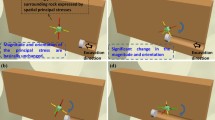Summary
Whenever solid or hollow inclusions are used as instrumented probes in overcoring techniques, “residual stresses” remain in the overcored rock sample and in the probes. When using such devices for computing the in-situ stress field components from measured strains or displacements, it is common practice to assume that the overcoring diameter is infinite and that there is a perfect bonding between the rock and the probes. The validity of these assumptions depends on the magnitude of the residual stresses at the rock-probe contact as compared to the tensile and shear strengths of the rock-probe bond material. It also depends on the distribution of residual stresses in the overcored sample.
In comparison to previous work, new expressions are proposed in this paper for the residual stresses associated with solid or hollow inclusion type stress probes in anisotropic ground. These expressions are presented in dimensionless form and are used to show that the distribution and magnitude of residual stresses depend on the isotropic-anisotropic rock character, the degree and type of rock anisotropy, the orientation of the rock anisotropy with respect to the hole in which the probes are located and the relative deformability of the rock with respect to the deformability of the material comprising the probes. The conditions that are required for neglecting the overcored sample diameter are also discussed. This is shown for rocks that can be described as isotropic, transversely isotropic and orthotropic materials.
Similar content being viewed by others
References
Amadei, B. (1983): Number of Boreholes to Measure the State of Stress in situ. Proc. 24th U. S. Rock Symp., Texas A & M Univ., pp. 87–98.
Amadei, B. (1982): The Influence of Rock Anisotropy on Measurement of Stresses in situ. Ph. D. thesis, Univ. of California, Berkeley. Also published by Springer-Verlag in: “Lecture Notes in Engineering,” series under the title, “Rock Anisotropy and the Theory of Stress Measurements,” (1983).
Amadei, B., Walton, R. J. (in preparation): Analysis of Data Obtained with the CSIRO Cell in Anisotropic Rock Masses. CSIRO report.
Becker, R. M. (1968): An Anisotropic Elastic Solution for Testing Stress Relief Cores. U. S. Bureau of Mines, RI. 7143.
Becker, R. M., Hooker, V. E. (1967): Some Anisotropic Considerations in Rock Stress Determinations. U. S. Bureau of Mines, RI. 6965.
Berry, D. S. (1968): The Theory of Stress Determination by Means of Stress Relief Techniques in Transversely Isotropic Medium. Tech. Report No. 5-68, Missouri River Division, Corps of Engineers, Omaha, Nebraska.
Berry, D. S. (1970): The Theory of Determination of Stress Changes in a Transversely Isotropic Medium Using an Instrumented Cylindrical Inclusion. Tech. Report No. MRD 1-70, Missouri River Division, Corps of Engineers, Omaha, Nebraska.
Berry, D. S., Fairhurst, C. (1966): Influence of Rock Anisotropy and Time Dependent Deformation on the Stress Relief and High Modulus Inclusion Techniques of in situ Stress Determination. In: Testing Techniques for Rock Mechanics, ASTM, STP. 402, Am. Soc. Testing Mats., pp. 190–206.
Blackwood, R. L. (1977): An Instrument to Measure the Complete Stress Field in Soft Rock or Coal in a Single Operation. Proc. Int. Symp. on Field Measurements in Rock Mechanics, Kovari, K. (ed.), Vol. 1, pp. 137–150, Zurich.
Blackwood, R. L. (1982): A Three-Dimensional Study of an Overcored Solid Inclusion Stress Instrument by the Boundary Integral Equation Method. Proc. 4th Int. Conf. in Australia on Finite Element Methods., pp. 109–113.
Duncan Fama, M. E. (1979): Analysis of a Solid Inclusion in situ Stress Measuring Device. Proc. 4th Cong. ISRM (Montreux), Vol. 2, pp. 113–120.
Duncan Fama, M. E., Pender, M. J. (1980): Analysis of the Hollow Inclusion Method for Measuring in situ Rock Stress. Int. J. Rock Mech. Min. Sci.17 (No. 3), 137–146.
Hirashima, K., Koga, A. (1977): Determination of Stresses in Anisotropic Elastic Medium Unaffected by Boreholes from Measured Strains or Deformations. Proc. Int. Symp. on Field Measurements in Rock Mechanics, Kovari, K. (ed.), Vol. 1, pp. 173–182.
Leeman, E. R., Hayes, D. J. (1966): A Technique for Determining the Complete State of Stress in Rock Using a Single Borehole, Proc. 1st. Cong. ISRM (Lisbon), Vol. II, pp. 17–24.
Merrill, R. H. (1967): Three Component Borehole Deformation Gage for Determining the Stress in Rock. U. S. Bureau of Mines, RI 7015.
Niwa, Y., Hirashima, K. (1971): The Theory of the Determination of Stress in an Anisotropic Elastic Medium Using an Instrumented Cylindrical Inclusion. Memoirs of the Faculty of Eng., Kyoto Univ., Japan, Vol. 33, pp. 221–232.
Pickering, D. J. (1970): Anisotropic Elastic Parameters for Soils. Geotechnique20 (No. 3), 271–276.
Rocha, M., Silverio, A. (1969): A New Method for the Complete Determination of the State of Stress in Rock Masses. Geotechnique19 (No. 1), 116–132.
Rocha, M., Silverio, A., Pedro, J. O., Delgado, J. S. (1974): A New Development of the LNEC Stress Tensor Gauge. Proc. 3rd Cong. ISRM (Denver), Vol. IIA, pp. 464–467.
Worotnicki, G., Walton, R. J. (1976): Triaxial Hollow Inclusion Gauges for the Determination of Rock Stress in situ. Proc. ISRM Symp. on Investigation of Stress in Rock and Advances in Stress Measurement. Supplement, pp. 1–8, Sydney.
Author information
Authors and Affiliations
Rights and permissions
About this article
Cite this article
Amadei, B. Applicability of the theory of hollow inclusions for overcoring stress measurements in rock. Rock Mech Rock Engng 18, 107–130 (1985). https://doi.org/10.1007/BF01019601
Issue Date:
DOI: https://doi.org/10.1007/BF01019601




